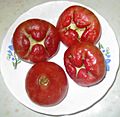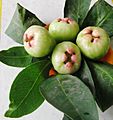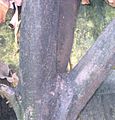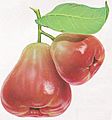Syzygium samarangense facts for kids
Quick facts for kids Syzygium samarangense |
|
|---|---|
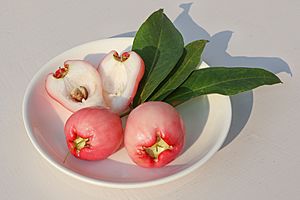 |
|
| Conservation status | |
| Scientific classification | |
| Genus: |
Syzygium
|
| Species: |
samarangense
|
| Synonyms | |
|
|
The Syzygium samarangense is a type of flowering plant. It belongs to the Myrtaceae family. This plant is often called the wax apple, Java apple, or wax jambu.
It originally comes from places like the Greater Sunda Islands, the Malay Peninsula, and the Andaman and Nicobar Islands. People started growing it a very long time ago. Now, you can find it in many warm, tropical parts of the world.
Contents
About the Wax Apple Tree
The wax apple tree is a tropical tree. It can grow up to 12 meters (about 39 feet) tall. Its leaves stay green all year round. The leaves are usually 10 to 25 cm (4 to 10 inches) long. They are also 5 to 10 cm (2 to 4 inches) wide. The leaves are shaped like an oval and are rounded at the bottom. If you crush them, they smell nice.
The tree's trunk is quite short. It has a wide, open top, or crown, that starts low on the tree. The bark is a pinkish-gray color. It peels off easily.
Flowers and Fruit
The flowers of the wax apple tree are white or yellowish-white. Each flower is about 2.5 cm (1 inch) across. They have four petals and many stamens. The flowers grow in groups of 3 to 30 near the ends of branches.
The fruit that grows from these flowers is edible. It looks like a bell. The fruit can be white, light green, or green. It can also be red, purple, crimson, or even deep purple to black. Wild plants usually have fruit that is 4 to 6 cm (1.6 to 2.4 inches) long. The fruit has four fleshy parts at its tip.
The skin of the fruit is thin. The inside is white and spongy. Each fruit usually has one or two round seeds. These seeds are not bigger than 0.8 cm (0.3 inches). The flowers and fruit can grow almost anywhere on the tree. You can find them on the trunk and branches, not just near the leaves. When the tree is fully grown, it produces a lot of fruit. It can yield up to 700 fruits in one crop.
What the Fruit Tastes Like
When a wax apple is ripe, it puffs outwards. It has a slight dip in the middle of its underside. Healthy wax apples look a bit shiny. Even though it's called a "wax apple," it doesn't taste like an apple. It also doesn't smell or feel as firm as an apple.
Its flavor is more like a snow pear. The amount of liquid inside is similar to a watermelon. But unlike apples or watermelons, the wax apple's inside is very loose. In the very middle, there's a seed. It sits in a soft, cotton-candy-like material. This part is safe to eat, but it doesn't have much flavor. The color of the juice depends on the type of wax apple. It can be purple or completely clear.
Wax Apple as Food
| Nutritional value per 100 g (3.5 oz) | |
|---|---|
| Energy | 105 kJ (25 kcal) |
|
5.70 g
|
|
|
0.30 g
|
|
|
Protein
|
0.60 g
|
| Vitamins | Quantity
%DV†
|
| Thiamine (B1) |
2%
0.020 mg |
| Riboflavin (B2) |
3%
0.030 mg |
| Niacin (B3) |
5%
0.800 mg |
| Vitamin C |
27%
22.3 mg |
| Minerals | Quantity
%DV†
|
| Calcium |
3%
29 mg |
| Iron |
1%
0.07 mg |
| Magnesium |
1%
5 mg |
| Phosphorus |
1%
8 mg |
| Potassium |
4%
123 mg |
| Sodium |
0%
0 mg |
| Zinc |
1%
0.06 mg |
| Other constituents | Quantity |
| Cholesterol | 0 mg |
|
Link to Full Nutrient Report of USDA Database entry
|
|
| †Percentages estimated using US recommendations for adults. | |
Many different types of wax apples have been grown. These types have larger fruits. Generally, the paler or darker the fruit, the sweeter it is. In Southeast Asia, the black ones are called "Black Pearl" or "Black Diamond." The very light greenish-white ones are called "Pearl." These "Pearl" fruits are often the most expensive in fruit markets.
People often serve the fruit whole, but with the core removed. This keeps its unique bell shape. In the cuisine of Indian Ocean islands, people often use the fruit in salads. They also use it in lightly sautéed dishes. It is mostly eaten as a fresh fruit. It is also used to make pickles, like "chambakka achar" in Kerala, India. In the Philippines, the fruit is called macopa. It is sometimes confused with tambis (Syzygium aqueum). Tambis is more commonly grown there.
Gallery
See also
 In Spanish: Syzygium samarangense para niños
In Spanish: Syzygium samarangense para niños









